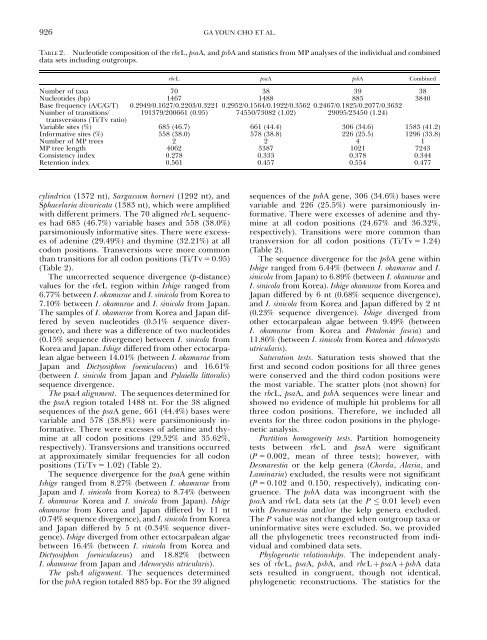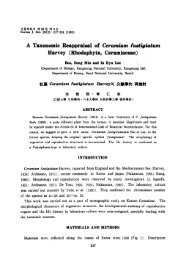A NEW BROWN ALGAL ORDER, ISHIGEALES (PHAEOPHYCEAE ...
A NEW BROWN ALGAL ORDER, ISHIGEALES (PHAEOPHYCEAE ...
A NEW BROWN ALGAL ORDER, ISHIGEALES (PHAEOPHYCEAE ...
You also want an ePaper? Increase the reach of your titles
YUMPU automatically turns print PDFs into web optimized ePapers that Google loves.
926<br />
TABLE 2. Nucleotide composition of the rbcL, psaA, and psbA and statistics from MP analyses of the individual and combined<br />
data sets including outgroups.<br />
cylindrica (1372 nt), Sargassum horneri (1292 nt), and<br />
Sphacelaria divaricata (1383 nt), which were amplified<br />
with different primers. The 70 aligned rbcL sequences<br />
had 685 (46.7%) variable bases and 558 (38.0%)<br />
parsimoniously informative sites. There were excesses<br />
of adenine (29.49%) and thymine (32.21%) at all<br />
codon positions. Transversions were more common<br />
than transitions for all codon positions (Ti/Tv 5 0.95)<br />
(Table 2).<br />
The uncorrected sequence divergence (p-distance)<br />
values for the rbcL region within Ishige ranged from<br />
6.77% between I. okamurae and I. sinicola from Korea to<br />
7.10% between I. okamurae and I. sinicola from Japan.<br />
The samples of I. okamurae from Korea and Japan differed<br />
by seven nucleotides (0.51% sequence divergence),<br />
and there was a difference of two nucleotides<br />
(0.15% sequence divergence) between I. sinicola from<br />
Korea and Japan. Ishige differed from other ectocarpalean<br />
algae between 14.01% (between I. okamurae from<br />
Japan and Dictyosiphon foeniculaceus) and 16.61%<br />
(between I. sinicola from Japan and Pylaiella littoralis)<br />
sequence divergence.<br />
The psaAalignment. The sequences determined for<br />
the psaA region totaled 1488 nt. For the 38 aligned<br />
sequences of the psaA gene, 661 (44.4%) bases were<br />
variable and 578 (38.8%) were parsimoniously informative.<br />
There were excesses of adenine and thymine<br />
at all codon positions (29.52% and 35.62%,<br />
respectively). Transversions and transitions occurred<br />
at approximately similar frequencies for all codon<br />
positions (Ti/Tv 5 1.02) (Table 2).<br />
The sequence divergence for the psaA gene within<br />
Ishige ranged from 8.27% (between I. okamurae from<br />
Japan and I. sinicola from Korea) to 8.74% (between<br />
I. okamurae Korea and I. sinicola from Japan). Ishige<br />
okamurae from Korea and Japan differed by 11 nt<br />
(0.74% sequence divergence), and I. sinicola from Korea<br />
and Japan differed by 5 nt (0.34% sequence divergence).<br />
Ishige diverged from other ectocarpalean algae<br />
between 16.4% (between I. sinicola from Korea and<br />
Dictyosiphon foeniculaceus) and 18.82% (between<br />
I. okamurae from Japan and Adenocystis utricularis).<br />
The psbA alignment. The sequences determined<br />
for the psbA region totaled 885 bp. For the 39 aligned<br />
rbcL psaA psbA Combined<br />
Number of taxa 70 38 39 38<br />
Nucleotides (bp) 1467 1488 885 3840<br />
Base frequency (A/C/G/T) 0.2949/0.1627/0.2203/0.3221 0.2952/0.1564/0.1922/0.3562 0.2467/0.1825/0.2077/0.3632<br />
Number of transitions/ 191379/200661 (0.95) 74550/73082 (1.02) 29095/23450 (1.24)<br />
transversions (Ti/Tv ratio)<br />
GA YOUN CHO ET AL.<br />
Variable sites (%) 685 (46.7) 661 (44.4) 306 (34.6) 1583 (41.2)<br />
Informative sites (%) 558 (38.0) 578 (38.8) 226 (25.5) 1296 (33.8)<br />
Number of MP trees 2 2 4 1<br />
MP tree length 4062 3387 1021 7243<br />
Consistency index 0.278 0.333 0.378 0.344<br />
Retention index 0.561 0.457 0.554 0.477<br />
sequences of the psbA gene, 306 (34.6%) bases were<br />
variable and 226 (25.5%) were parsimoniously informative.<br />
There were excesses of adenine and thymine<br />
at all codon positions (24.67% and 36.32%,<br />
respectively). Transitions were more common than<br />
transversion for all codon positions (Ti/Tv 5 1.24)<br />
(Table 2).<br />
The sequence divergence for the psbA gene within<br />
Ishige ranged from 6.44% (between I. okamurae and I.<br />
sinicola from Japan) to 6.89% (between I. okamurae and<br />
I. sinicola from Korea). Ishige okamurae from Korea and<br />
Japan differed by 6 nt (0.68% sequence divergence),<br />
and I. sinicola from Korea and Japan differed by 2 nt<br />
(0.23% sequence divergence). Ishige diverged from<br />
other ectocarpalean algae between 9.49% (between<br />
I. okamurae from Korea and Petalonia fascia) and<br />
11.86% (between I. sinicola from Korea and Adenocystis<br />
utricularis).<br />
Saturation tests. Saturation tests showed that the<br />
first and second codon positions for all three genes<br />
were conserved and the third codon positions were<br />
the most variable. The scatter plots (not shown) for<br />
the rbcL, psaA, and psbA sequences were linear and<br />
showed no evidence of multiple hit problems for all<br />
three codon positions. Therefore, we included all<br />
events for the three codon positions in the phylogenetic<br />
analysis.<br />
Partition homogeneity tests. Partition homogeneity<br />
tests between rbcL and psaA were significant<br />
(P 5 0.002, mean of three tests); however, with<br />
Desmarestia or the kelp genera (Chorda, Alaria, and<br />
Laminaria) excluded, the results were not significant<br />
(P 5 0.102 and 0.150, respectively), indicating congruence.<br />
The psbA data was incongruent with the<br />
psaA andrbcL data sets (at the P 0.01 level) even<br />
with Desmarestia and/or the kelp genera excluded.<br />
The P value was not changed when outgroup taxa or<br />
uninformative sites were excluded. So, we provided<br />
all the phylogenetic trees reconstructed from individual<br />
and combined data sets.<br />
Phylogenetic relationships. The independent analyses<br />
of rbcL, psaA, psbA, and rbcL þ psaA þ psbA data<br />
sets resulted in congruent, though not identical,<br />
phylogenetic reconstructions. The statistics for the




